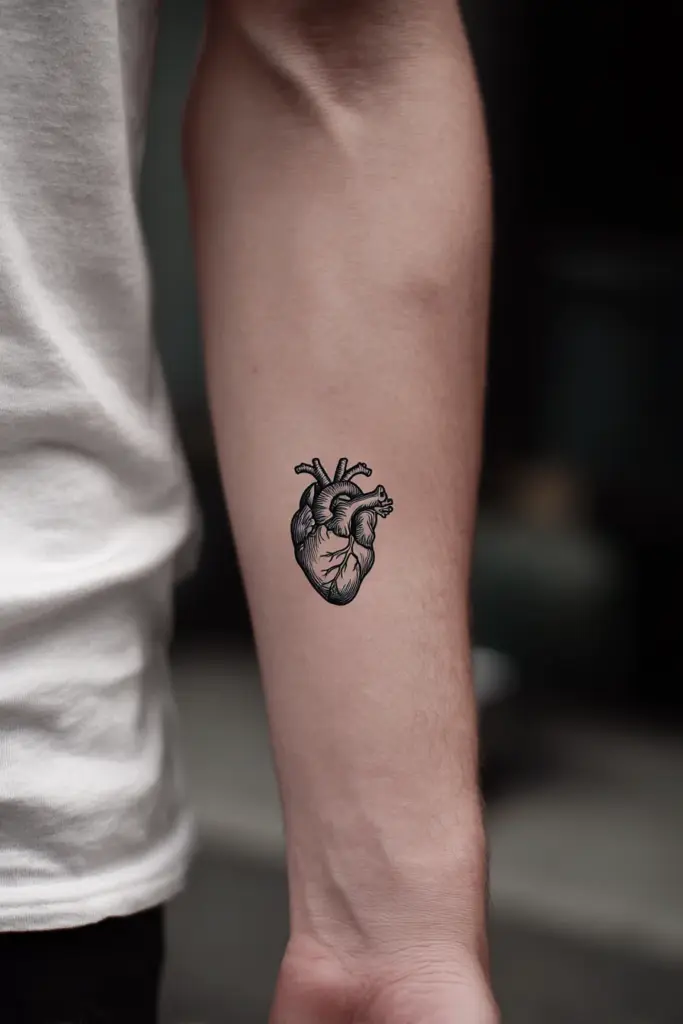I’m Hakan — a tattoo consultant and designer with over a decade working in modern tattoo culture and helping hundreds of men find the right piece. Small tattoos are perfect for first-timers, professionals who need discretion, travelers, and anyone seeking a subtle, personal statement. In this post I present 22 small tattoo ideas and practical guidance drawn from real consultations and studio experience. You’ll learn how to choose placement that fits daily life, pick the right scale and line weight for longevity, and decide between black, grey, or a touch of color. I also cover pain expectations, aftercare essentials, and how to vet artists for fine-line or single-needle work. Whether you want a tiny symbol on your wrist, a micro-script on a rib, or a discreet chest motif, these suggestions prioritize tasteful design, technical feasibility, and long-term wearability.
Fine-Line Winged Dagger Forearm Tattoo — Minimalist Dotwork & Symmetry
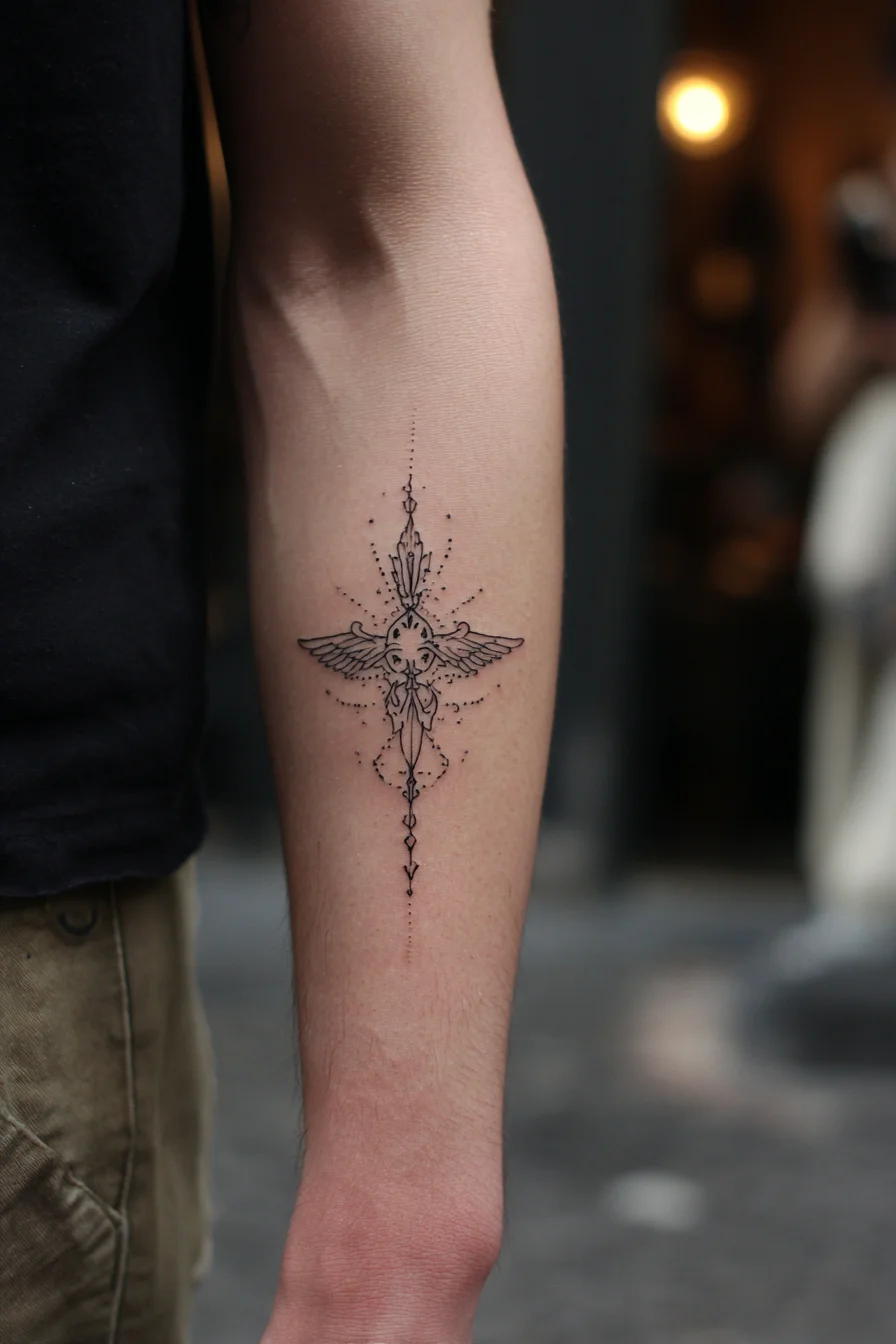
This slender, symmetrical design combines a dagger-like vertical axis with delicate wings and dotwork accents — a visual blend of direction, protection and balance. For men it reads as subtle masculinity: the dagger element suggests resilience and focus while the wings introduce freedom and aspiration. Ideal placement is the inner forearm as shown for everyday visibility and low-to-moderate pain; alternatives include the outer forearm, upper arm, or centered on the sternum for a bolder statement. Expect pain on the inner forearm to be mild-to-moderate (generally 2–5/10); moving to ribs, spine or hands will increase discomfort significantly. Size considerations are important: to retain the fine-line and dot detail, plan at least 3–4 cm in width and 10–15 cm in length — smaller versions risk blurring over time. Styling variations include heavier blackwork outlines for longevity, selective color fills (rust, navy or muted teal), added shading for depth, or converting the motif into geometric/tribal iterations. Note: fine-line and dotwork require careful aftercare and occasional touch-ups to maintain crispness.
Minimal Heartbeat & Medical Staff Forearm Tattoo — Heartbeat Linework Design
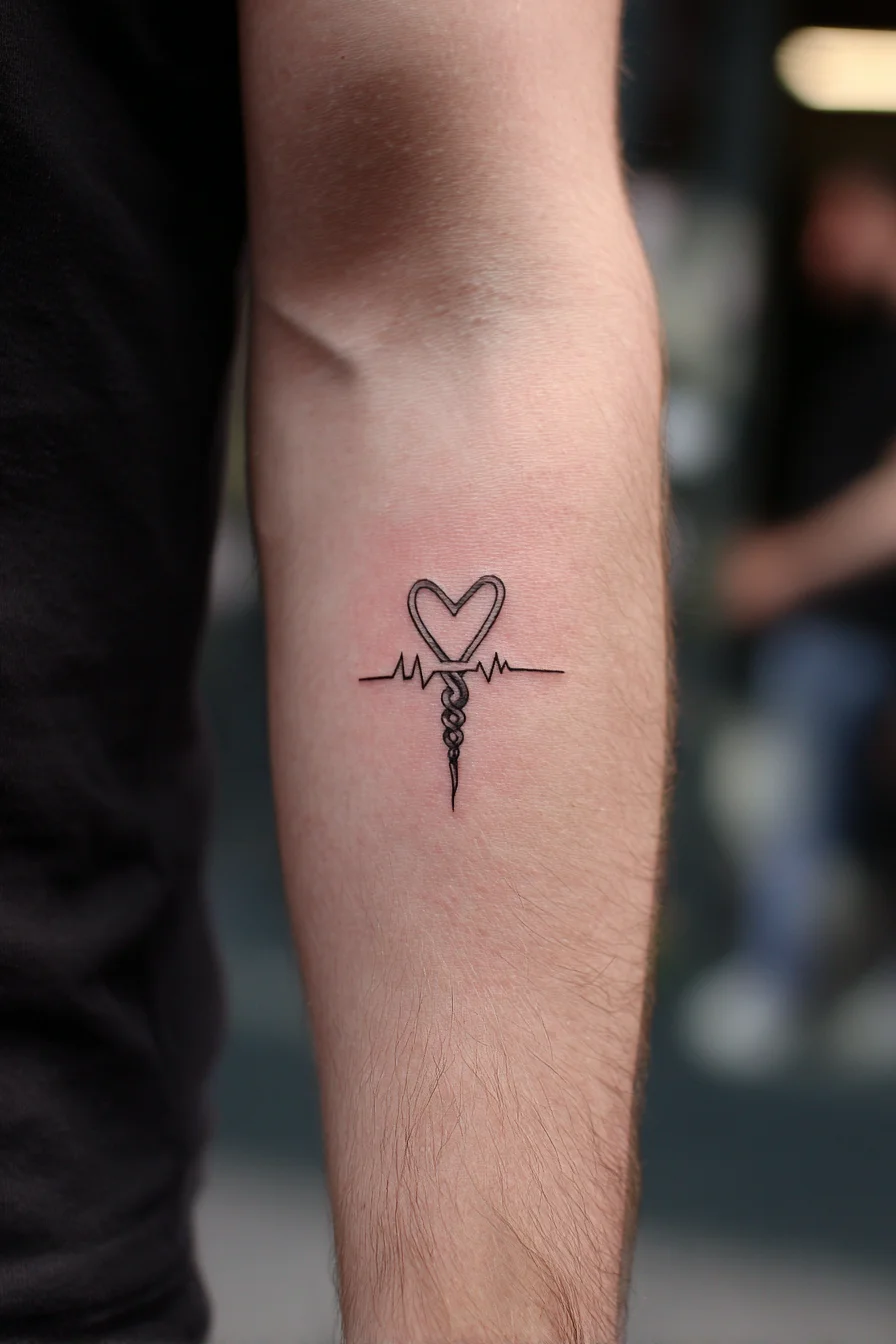
This clean, minimalist design pairs an outlined heart with an EKG pulse and a twisted staff motif, making it a strong symbol of life, care, and personal resilience — often chosen by men in healthcare or those honoring a loved one’s recovery. Placement: the inner forearm (as pictured) offers high visibility, easy aftercare, and a masculine display; alternatives include the outer forearm, upper arm, chest, or calf depending on how discreet or prominent you want it. Pain & healing: forearm tattoos are generally low-to-moderate in pain; expect some soreness for 5–7 days and follow standard aftercare to avoid scabbing. Size & longevity: fine-line detail works best at roughly 2–4 inches; very small iterations risk line spread over time, so consider slightly bolder lines if you want long-term crispness. Styling variations: solid black bolding for longevity, subtle red or watercolor accents behind the heart, added initials or dates, or a more detailed caduceus/stethoscope integration. Discuss line thickness and touch-up plans with your artist to balance detail and durability.
Caduceus Forearm Tattoo — Medical Symbol, Blackwork Linework for Men
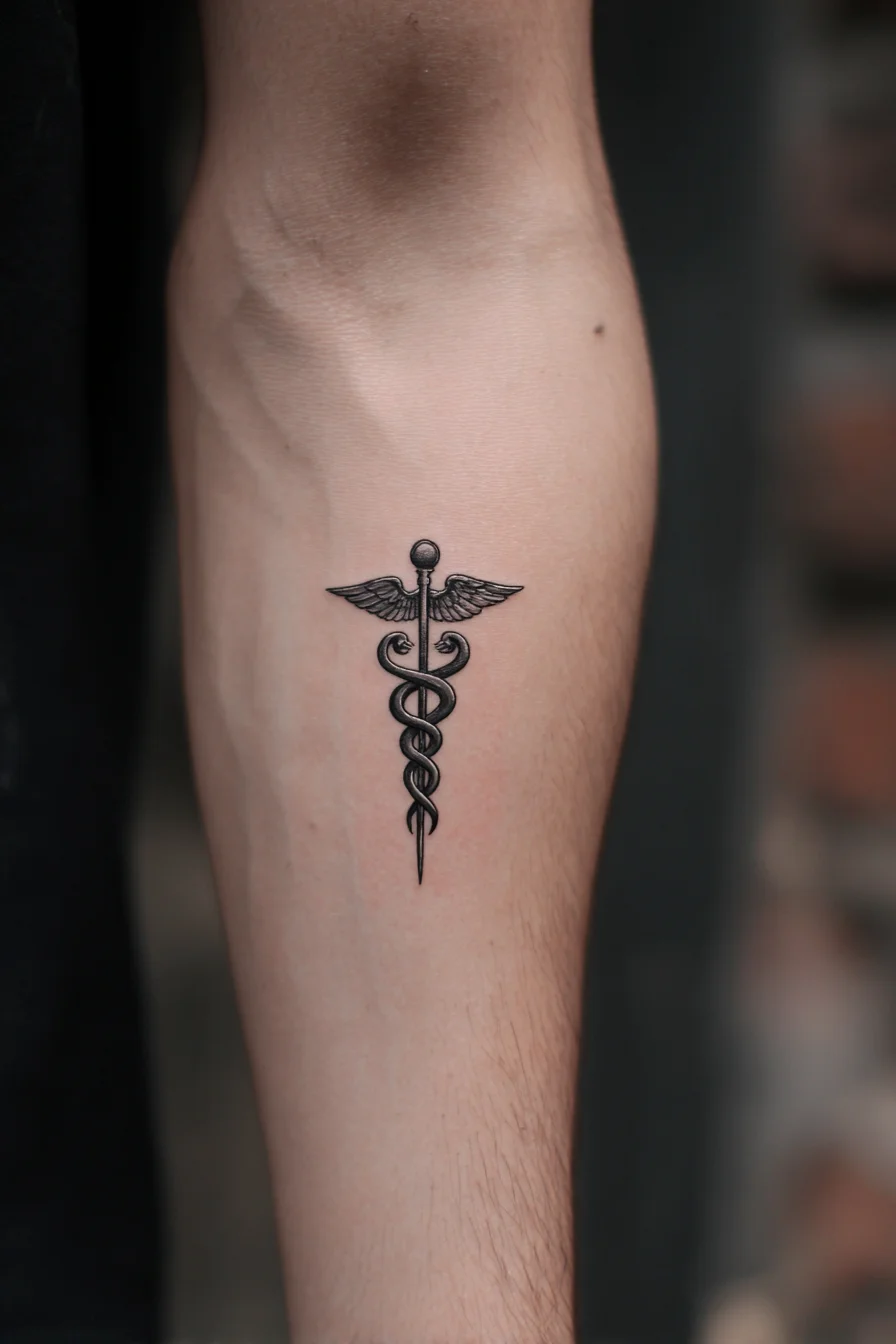
This caduceus design (winged staff with two serpents) communicates healing, protection, balance and a connection to medicine or caregiving. Its vertical, symmetrical form reads well on the inner or outer forearm and projects a clean, professional look suited to men who want a meaningful yet understated piece. Placement suggestions: inner forearm for visibility and lower pain, outer forearm for a more rugged presentation; alternative sites include the upper arm, chest or calf depending on size and coverage preference. Pain level expectations: forearm tattoos are generally low-to-moderate in discomfort; expect sharper sensitivity near the wrist and elbow creases but manageable sessions for small-to-medium pieces. Size considerations: 2–4 inches vertically keeps details crisp for fine-line or blackwork; scale up to 5–7 inches if you want added shading, texture or background elements. Styling variations: solid blackwork or fine-line ink, dotwork shading for a subtle textured finish, realistic snakes with color accents, or geometric/tribal framing to increase masculinity. Discuss line thickness and contrast with your artist to ensure longevity and clear detail over time.
Realistic Stag & Pine Forest Tattoo — Black & Grey Forearm Design
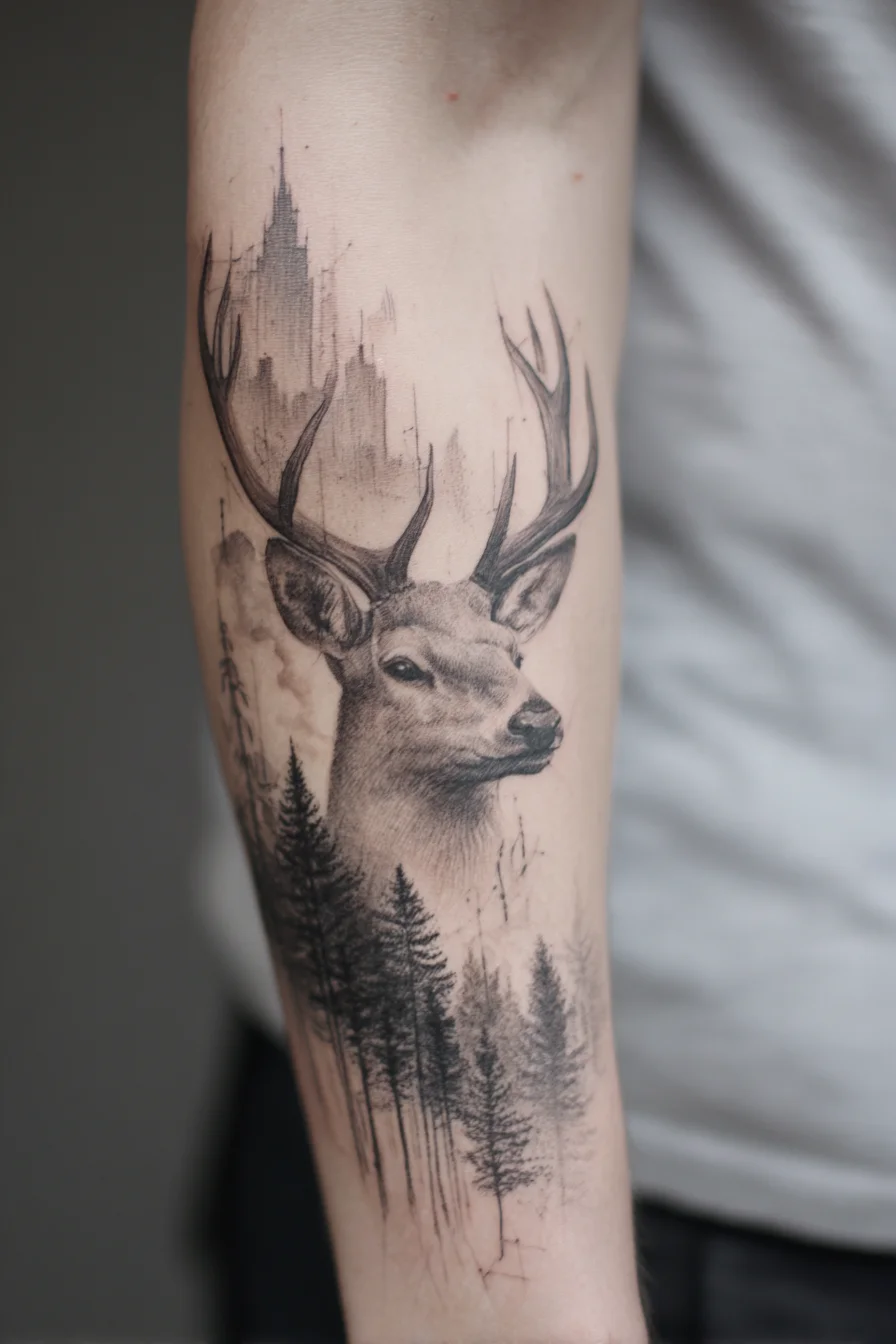
This black-and-grey stag with a pine forest blends realism and atmospheric shading to symbolize strength, leadership, and a deep connection to nature — themes many men choose to express through body art. The composition suits the inner or outer forearm (as pictured) for visibility and flow, but also adapts well to the upper arm, chest, calf, or as part of a sleeve. Expect pain to be low-to-moderate on fleshy forearm areas; discomfort increases near the wrist, inner elbow, ribs, or shoulder blade where bone and thin skin make sessions more intense. For crisp antler lines and tree detail, plan a medium-to-large canvas — roughly 6–8 in (15–20 cm) or larger — to retain texture and shading over time. Styling variations include high-contrast realism, soft watercolor washes behind the antlers, dotwork or stippling for the trees, geometric overlays, or reduced minimalist silhouettes for a subtler look. Discuss placement, size, and touch-up strategy with your artist to balance detail, aging, and personal pain tolerance before booking a session.
Small Blackwork Floral Cluster Tattoo – Inner Forearm Placement
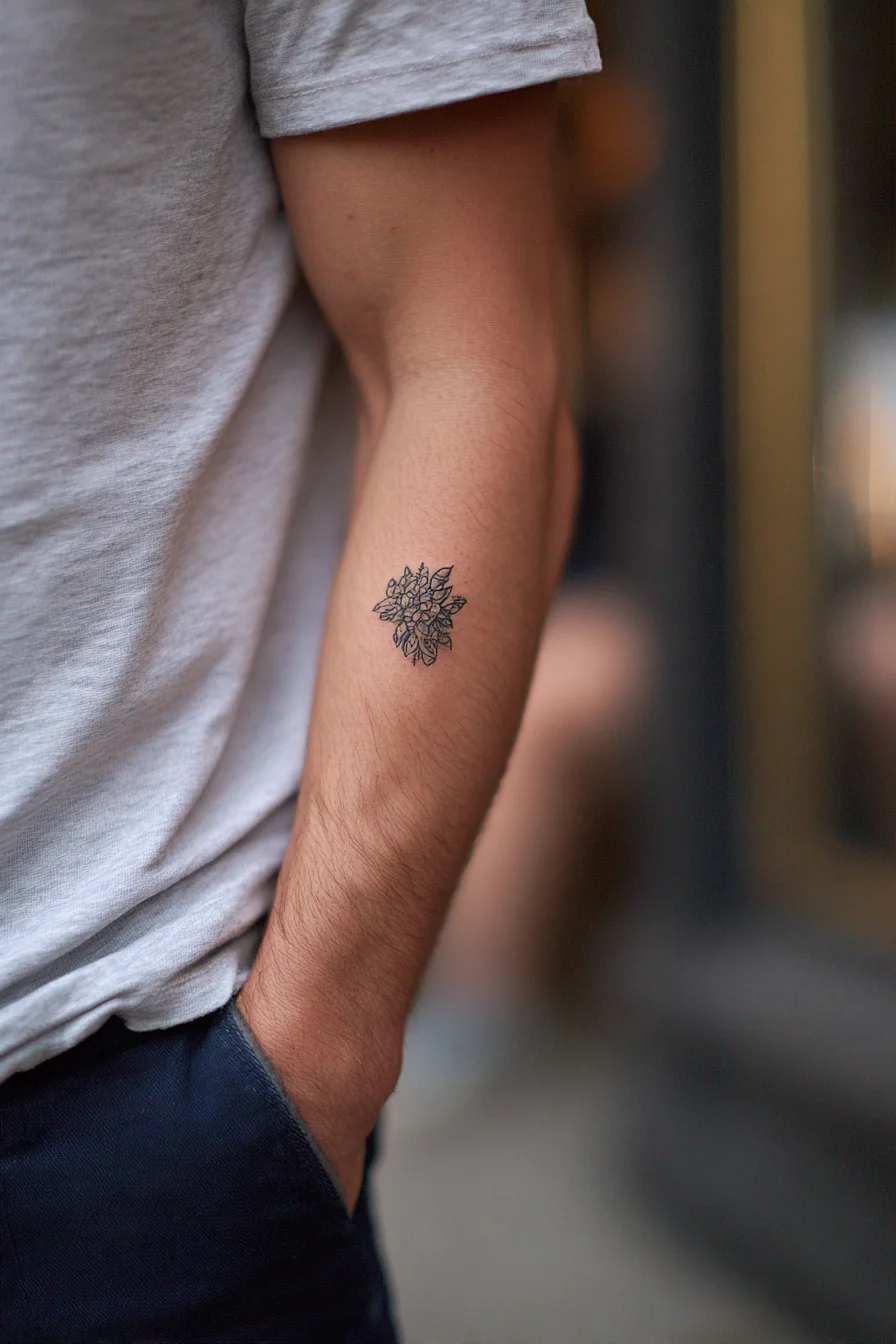
Compact blackwork floral cluster that balances delicate linework with a bold silhouette. It reads as a symbol of growth, resilience, and personal history — a masculine take on botanical imagery suited to men who want subtle, meaningful ink. Best placed on the inner forearm for daily visibility and easy concealment with long sleeves; outer forearm, bicep, or upper shoulder also work if you prefer more space. Pain expectations are generally low to moderate on fleshy areas like the inner forearm and bicep; expect more sensitivity near the wrist, elbow crease, or collarbone. Size considerations: 1.5–2.5 inch designs keep details crisp and heal faster, while 3–5 inch versions allow more shading and line variation. Opt for thicker lines if you want a longer-lasting, more rugged look; choose fine-line blackwork or dotwork for a refined, contemporary style. Styling variations include solid black silhouette, dot-shaded background, subtle color accents (deep green or muted burgundy), or integration into a sleeve with geometric elements. Discuss line weight and placement with your artist to match your pain tolerance and lifestyle.
Geometric Compass Rose Forearm Tattoo — Nautical Compass, Dotwork & Linework
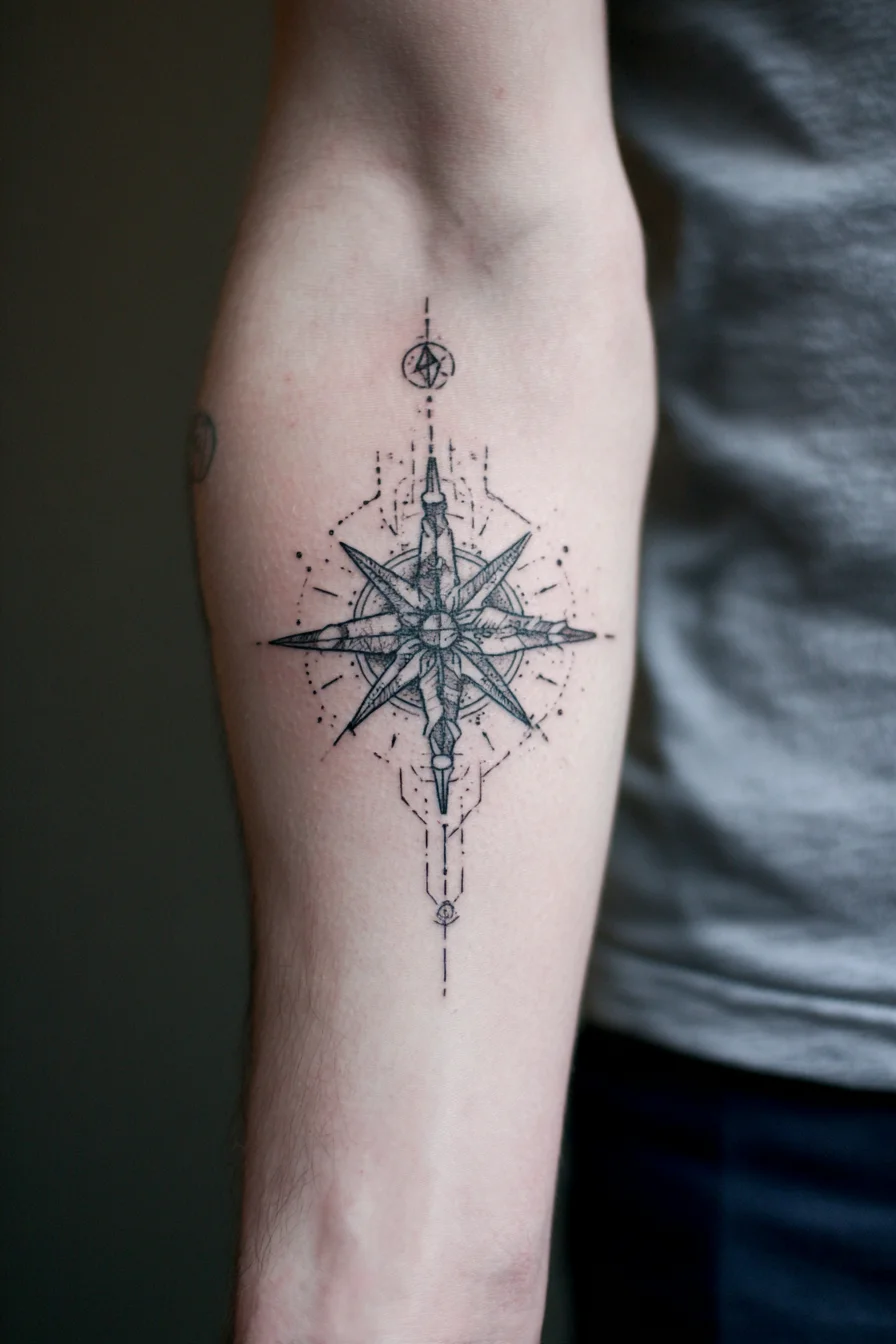
This detailed compass rose blends sharp linework and delicate dotwork to symbolize direction, personal purpose, and steady navigation through life’s challenges. For men seeking a meaningful yet refined piece, it reads as both a map to personal values and a subtle emblem of exploration and protection. Placement suggestions: the inner or outer forearm (as shown) offers ideal flat canvas for crisp detail and easy visibility; alternatives include the upper arm, chest, or calf for larger-scale versions. Pain and healing: forearm tattoos are generally low-to-moderate in discomfort — the inner forearm is slightly more sensitive than the outer — with most clients reporting manageable soreness and a 2–3 week initial heal. Size considerations: keep the piece medium (around 3–6 inches) to retain fine-point detail; very small renditions will lose the dotwork texture, while large pieces allow for added shading and background elements. Styling variations: convert to bold blackwork for longevity, add subtle color (a red north needle), incorporate coordinates, map fragments, or integrate realism for a vintage brass compass effect. Ask your artist about thicker primary lines to prevent future blurring and plan touch-ups for high-detail areas.
Minimal Pointing Hand Wrist Tattoo — Small Linework Design
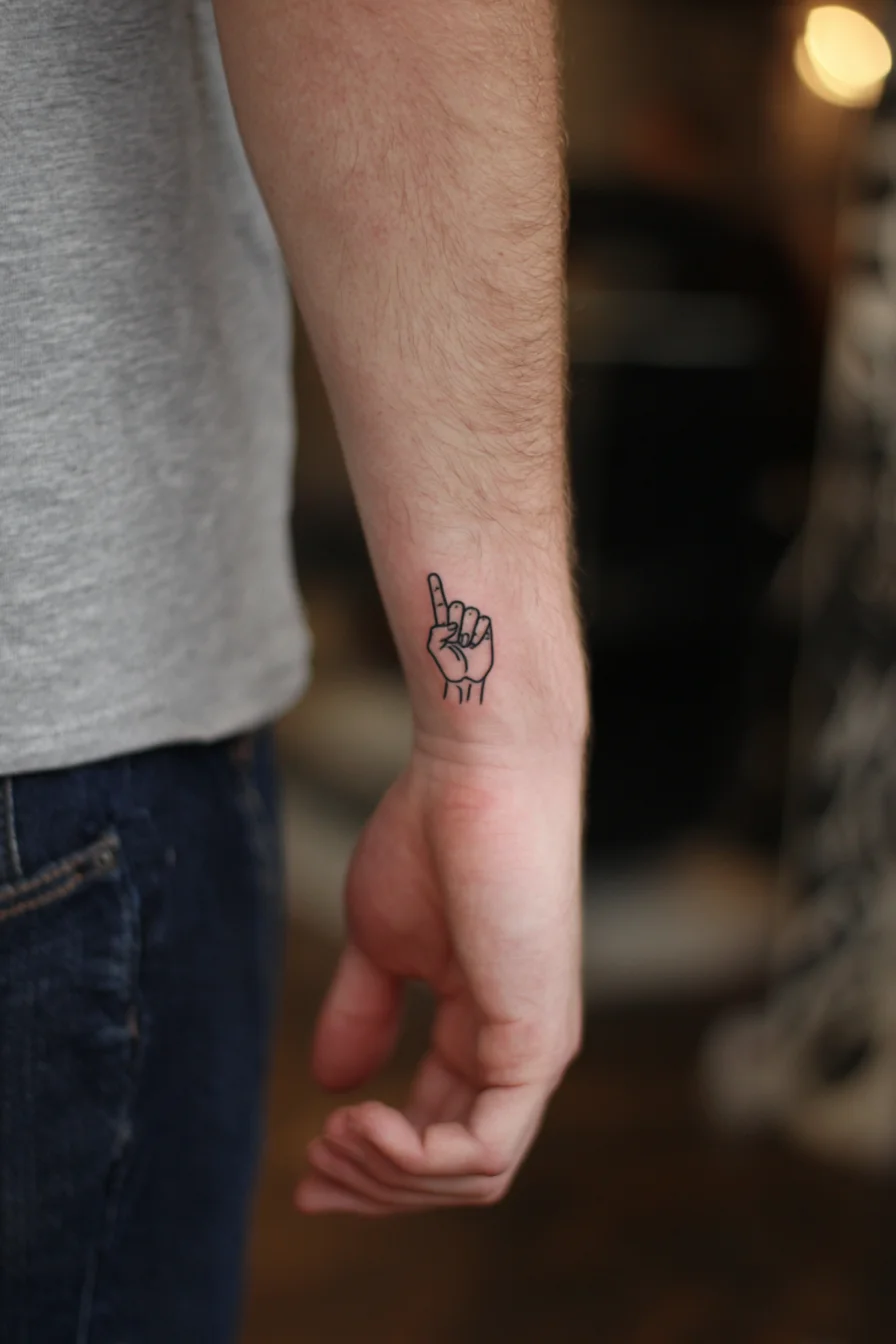
This minimalist pointing-hand tattoo—clean single-line outline of an index finger raised—reads as a compact symbol of direction, focus, or “number one” mentality. For men seeking a discreet yet meaningful mark, the inner wrist shown here is ideal: highly visible for personal reminders and easy to conceal with sleeves or a watch when needed. Expect moderate pain; because the inner wrist has thinner skin and nerves near tendons and bone, small pieces are more tolerable than larger shaded work. For size, 1.5–3 inches keeps line clarity without overcrowding; very fine detail under 1.5 inches can blur over time. Styling options include bold black linework for a masculine, graphic look; thicker, slightly shaded forms for depth; dotwork or micro‑realism for a softer effect; or adding script, a small date, or geometric framing to personalize it. Alternative placements that suit male anatomy include the outer forearm, bicep inner band, or behind the elbow crease. Talk with your tattooist about line weight and aftercare, and schedule sessions when you can rest your wrist to aid healing.
World Map Dotwork Tattoo — Minimal Forearm Travel Ink
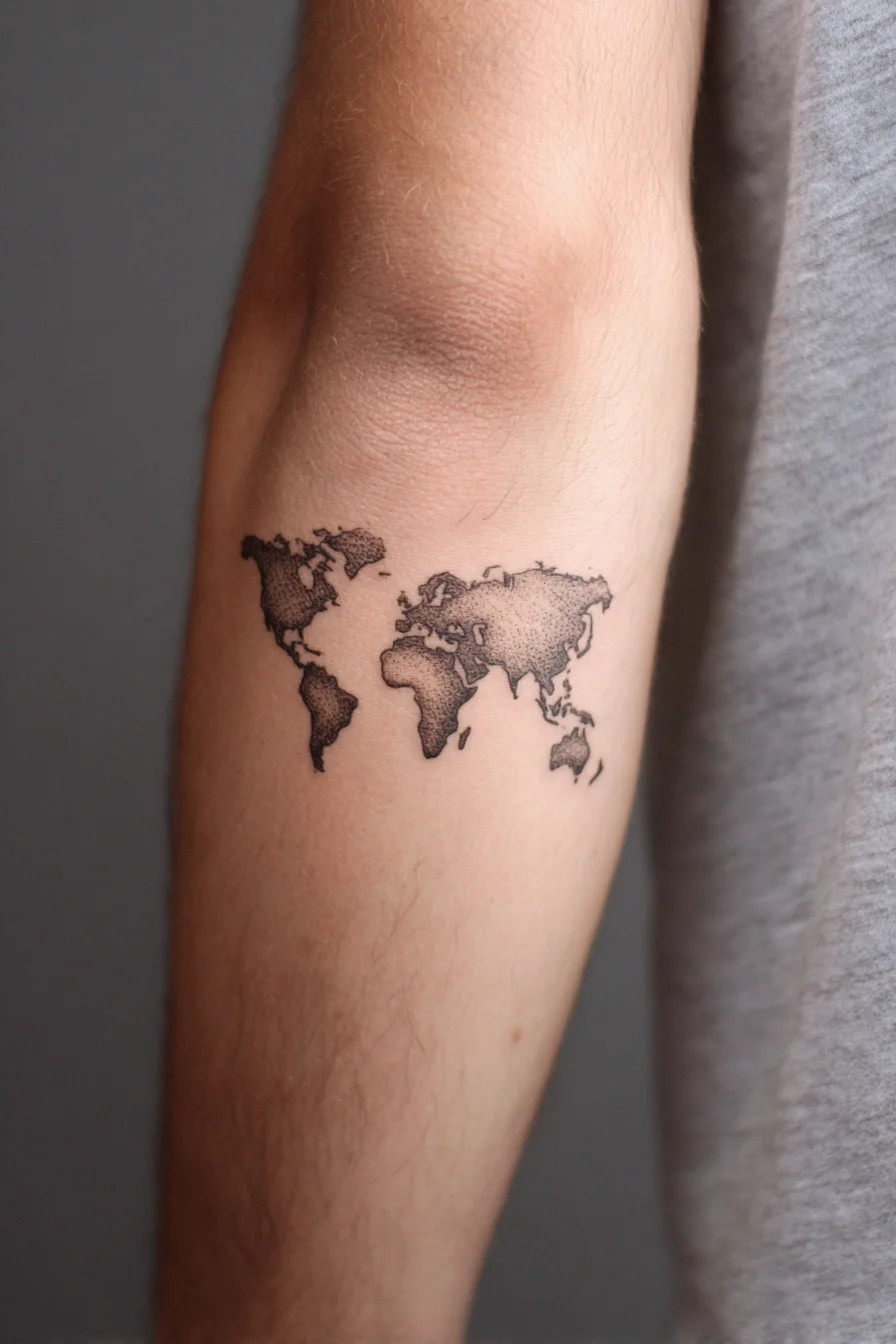
This minimalist world map in dotwork style symbolizes travel, curiosity, and a global outlook — a subtle way for men to declare a love of exploration or commemorate journeys and life milestones. The clustered dot shading creates texture without heavy solid fills, keeping the design lightweight and masculine. Ideal placement is the inner or outer forearm as shown for visibility and easy concealment with long sleeves; other good options are the upper arm, chest, or shoulder blade if you want a larger or more private piece. Expect a low-to-moderate pain level on the fleshy forearm; areas closer to bone or the inner elbow are more sensitive. For size, maintain enough scale for the dotwork detail to read clearly — typically at least 3–4 inches (8–10 cm) across for small continent shapes; larger pieces will allow finer stippling and more accurate coastlines. Styling variations include bold line silhouettes, fine-line continental outlines, watercolor washes behind the map, compass or coordinate accents, travel routes, or geometric overlays. Ask your artist about contrast and dot size to ensure longevity and legibility on male skin tones.
Minimalist Mountain Landscape Forearm Tattoo — Fine‑Line Sun & Birds
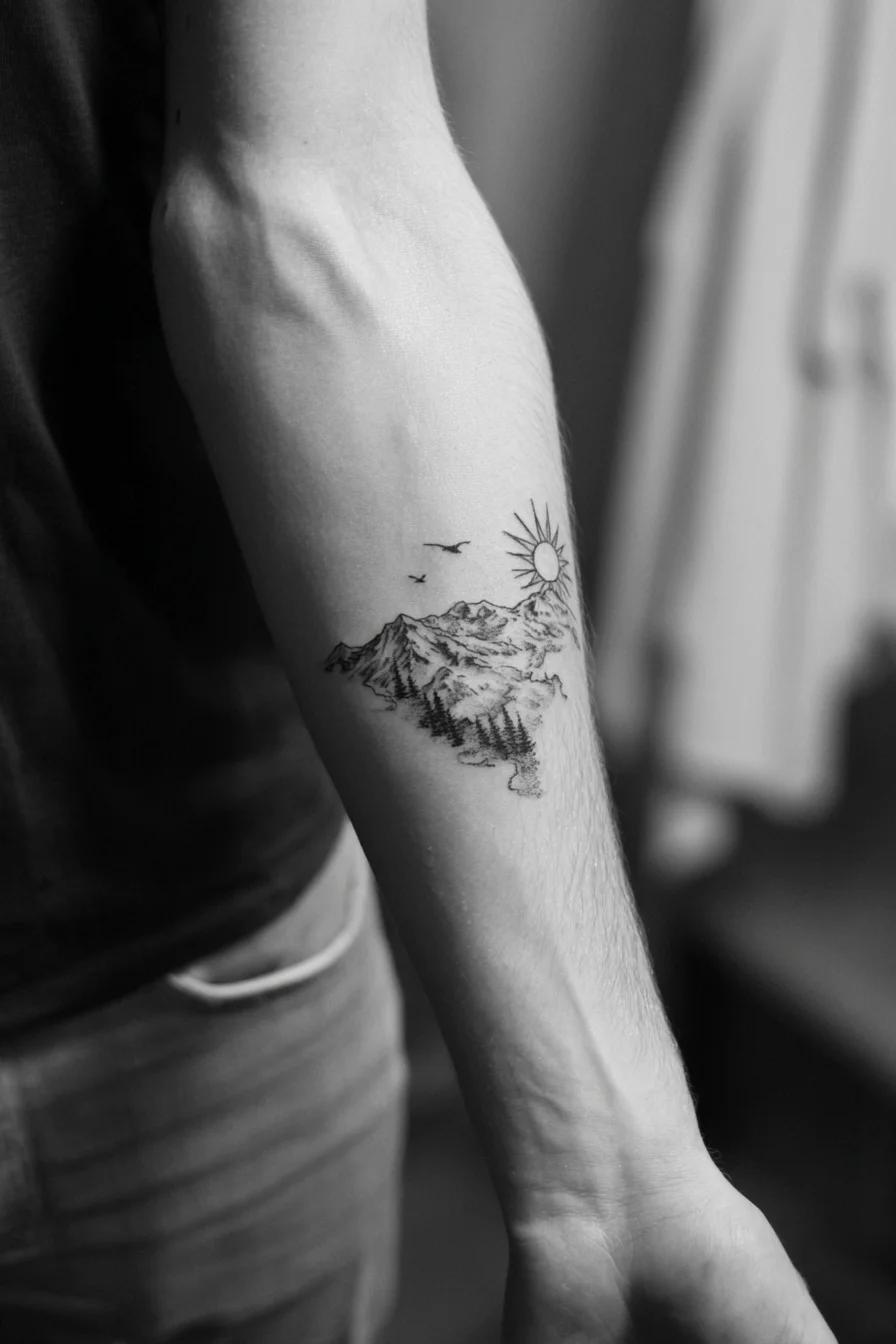
This compact mountain landscape with a rising sun, pines and flying birds reads as a classic outdoorsman’s emblem: resilience, direction and freedom. The design suits men who want symbolic, understated body art that evokes adventure and steady grounding without loud imagery. Placement suggestions: the inner or outer forearm (as shown) provides good visibility and low distortion; alternatives include the upper arm, calf or chest where the motif can be scaled up. Pain level expectations: as a fine‑line, single‑needle piece on the forearm you can expect mild to moderate discomfort — roughly a 2–5/10 — with increased sensitivity near the wrist, inner elbow or bony areas. Size considerations: keep the line detail at least 2–4 inches wide to preserve mountain texture and bird shapes; reducing below ~1.5 inches risks losing definition over time. Styling variations: black single‑needle or dotwork maintains a minimalist look, while light wash shading or selective color (warm sun tones, muted greens) adds dimension. For best results choose an artist experienced in fine‑line landscapes and discuss scaling, ink density and aftercare during consultation.
Anchor & Arrow Forearm Tattoo — Masculine Nautical Linework Design
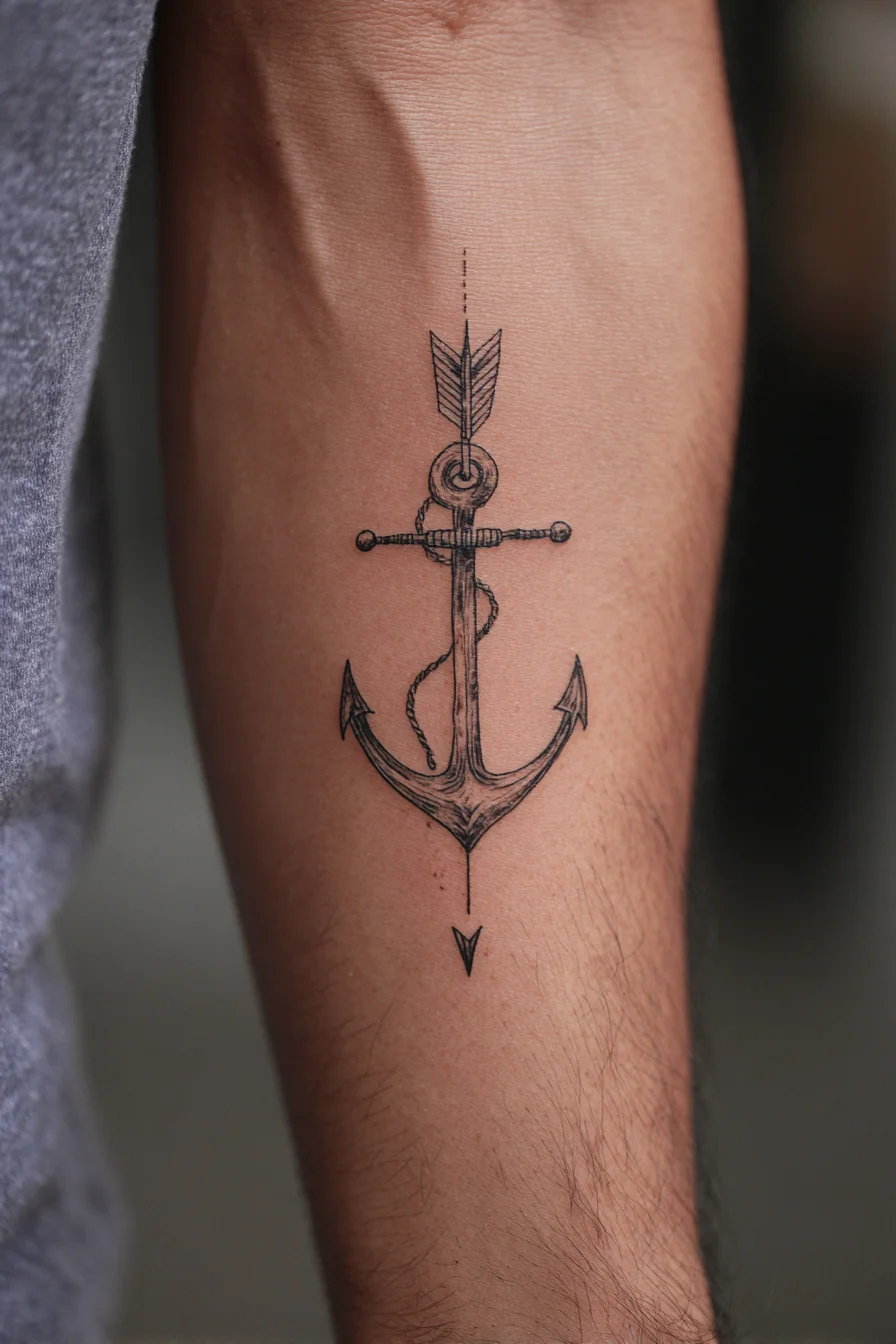
Clean anchor and arrow motifs combine classic nautical symbolism with directional intent — ideal for men seeking a subtle, masculine piece. The anchor represents stability, home and resilience; the arrow adds movement, focus and forward momentum. Together they read as grounded purpose or a steady path forward. Placement: this vertical composition suits the inner or outer forearm (as shown), running with the muscle for natural flow. It also translates well to the bicep, calf or center chest. Forearm placement offers high visibility and easy concealment with long sleeves. Pain level: expect low to moderate discomfort on the forearm. Outer forearm is among the least painful areas; wrist, ribs and sternum are notably more sensitive. Sessions are manageable for small to medium sizes. Size and detail: keep at least three to five inches to preserve fine linework and rope texture; smaller pieces risk line blowout over time. For larger tattoos, add subtle shading or wood grain details to increase depth. Styling variations: bold traditional black, precise single-needle linework, dotwork shading, or selective navy or teal accents. Consider adding a compass, engraved initials or a date banner to personalize. Consult your artist about scale and skin tone before booking.
Ornate Compass-Cross Forearm Tattoo — Dotwork Blackwork Design
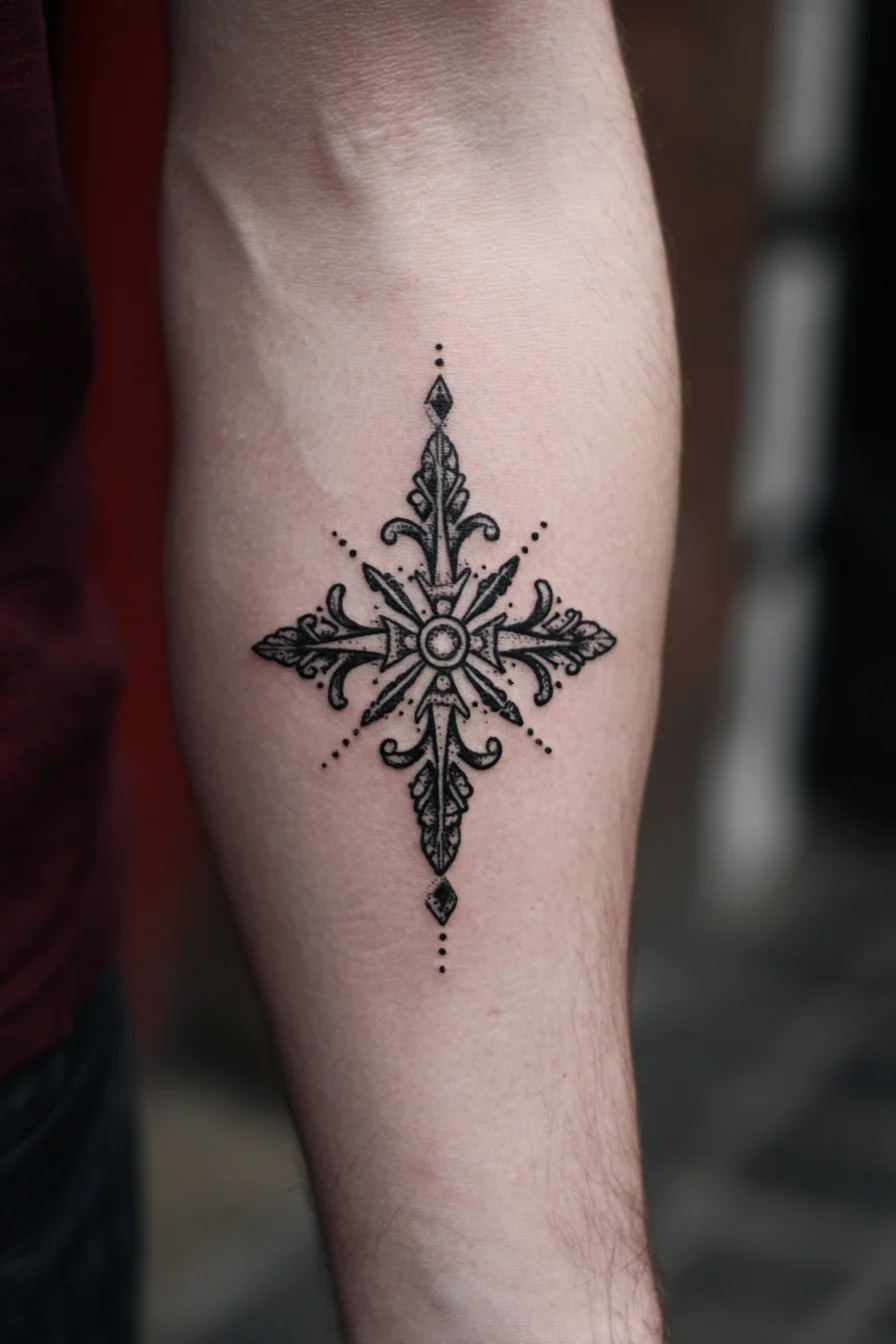
This ornate compass-cross blends classic symbolism (direction, balance, personal code) with decorative filigree for a masculine, refined look. As a forearm piece it reads well as a standalone statement or as the focal point of a sleeve, offering a strong vertical axis that complements the arm’s natural lines. Expect low-to-moderate discomfort on the inner forearm — flatter, fleshy areas are easier than bony zones near the wrist or elbow, where pain and sensitivity increase. For size, keep fine filigree at least 3–6 inches tall to preserve detail over time; anything under 2 inches risks blurring as lines settle. Discuss needle grouping and line weight with your artist to maintain crisp dotwork and ornamental shading. Styling variations include solid blackwork for bold contrast, delicate dotwork and stippling for texture, subtle color accents (bronze or deep blue) for depth, or negative-space highlights for a more modern look. Practical notes for men: consider hair growth and workplace visibility when choosing placement, and consult an experienced artist to scale the design to your anatomy and long-term wear.
Minimal EKG Heartbeat Wrist Tattoo — Small Linework Heart & Pulse
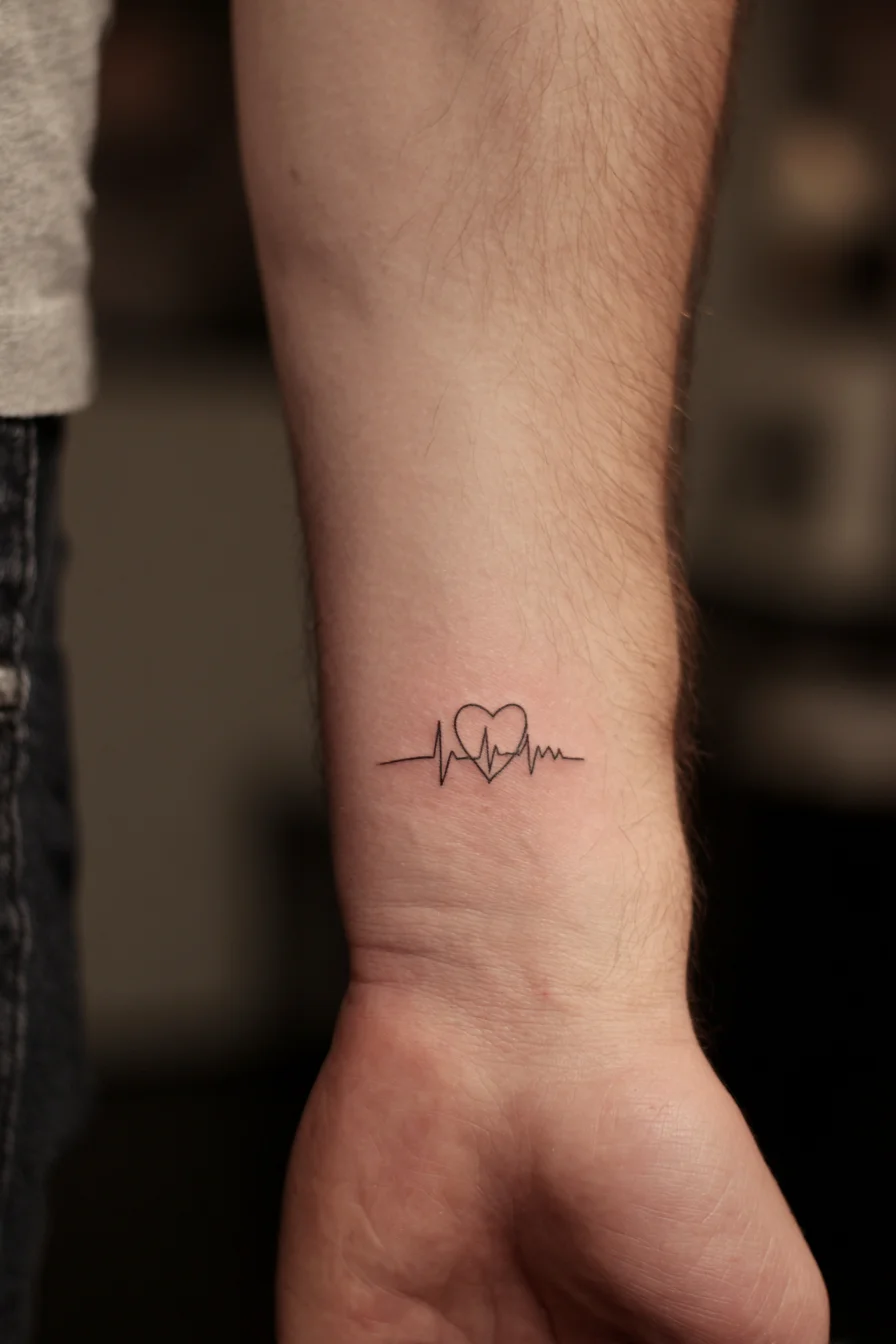
This minimalist heartbeat (EKG) tattoo pairs a clean pulse line with an outlined heart to convey life, loyalty, or personal resilience. The understated, single-line look reads as meaningful without being loud — ideal for men who want a discreet emblem of connection or remembrance. Placement suggestions: inner wrist (as shown) for visibility and intimacy; outer wrist or forearm for easier concealment under sleeves; bicep or chest if you prefer a larger, more private version. Pain expectations: the inner wrist is more sensitive and tends to register moderate pain during short sessions; outer forearm and bicep are milder. Size considerations: 2–5 cm suits wrist placement and keeps lines crisp; scale to 6–12 cm for forearm work to allow thicker line weights and detail. Styling variations: ultra-fine single-line, bolder black linework, filled or shaded heart, integrated initials/dates, or a watercolor splash for color contrast. Discuss line thickness, placement over veins/hair, and aftercare with your artist to ensure longevity and readability.
Minimal Hourglass Tattoo — Fine-Line Forearm Timepiece Design
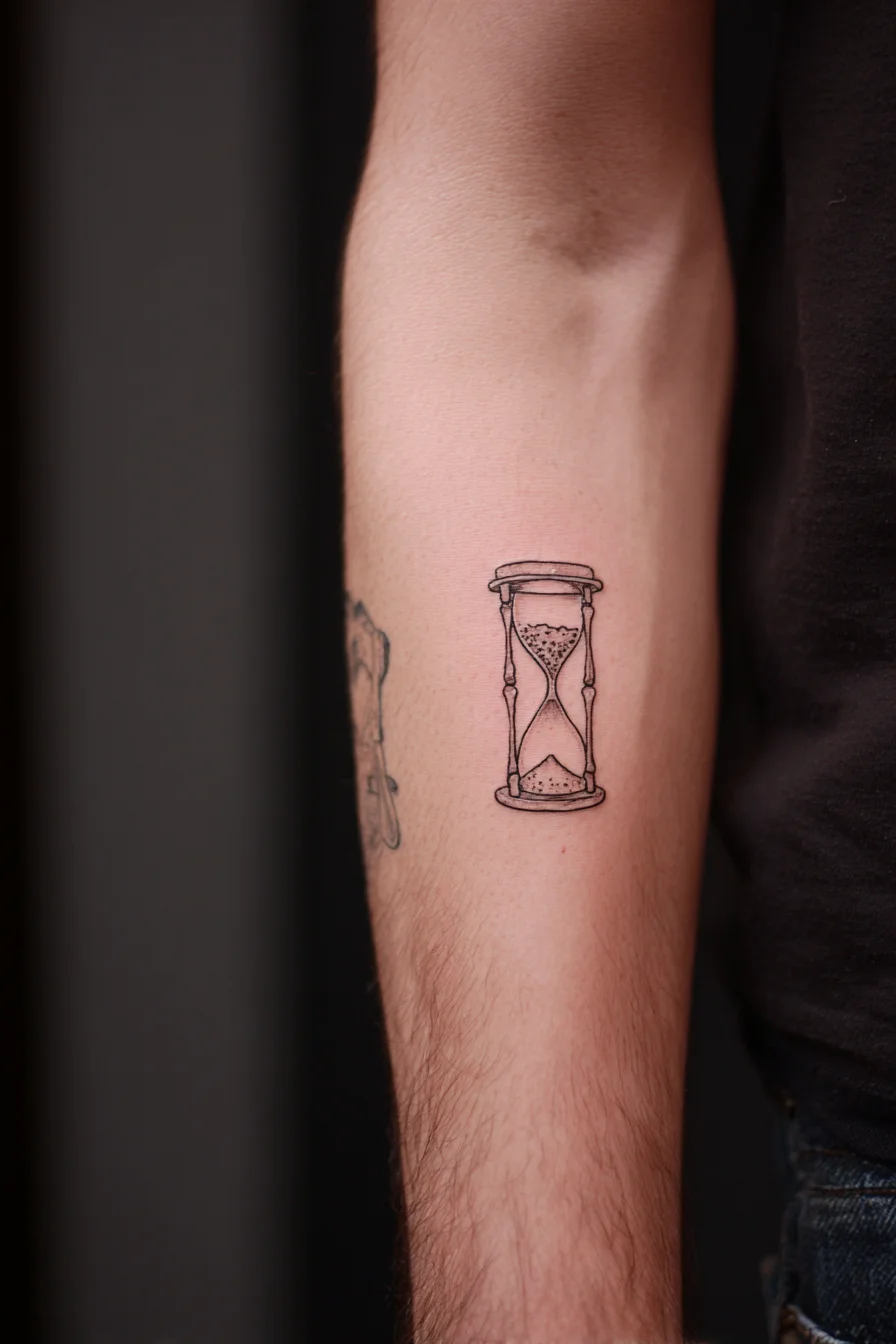
An hourglass tattoo is a compact, symbolic piece that represents the passage of time, mortality, patience, and balance. For men seeking a refined motif, a fine-line hourglass on the forearm delivers strong visual impact without heavy coverage. Placement: the inner or outer forearm (as pictured) offers prime visibility and easy concealment under long sleeves; alternative locations include the bicep, chest, wrist, or ribs depending on whether you want a discreet or dramatic placement. Pain expectations: forearm work is typically low-to-moderate in pain compared with ribcage, spine, or ankle tattoos. Expect increased sensitivity near the wrist and over bony areas, while fleshier zones like the upper arm feel milder. Size considerations: keep the design at least 2–3 inches tall to preserve fine-line detail and dotwork; scale up if you plan added shading, realism, or integrated elements. Styling variations: black fine-line, dotwork shading, bold blackwork silhouettes, photorealistic glass and sand, or subtle watercolor accents. Discuss line weight, sizing, and aftercare with your artist to ensure crisp, long-lasting results.
Minimal Sailboat Tattoo — Small Forearm Nautical Design for Men
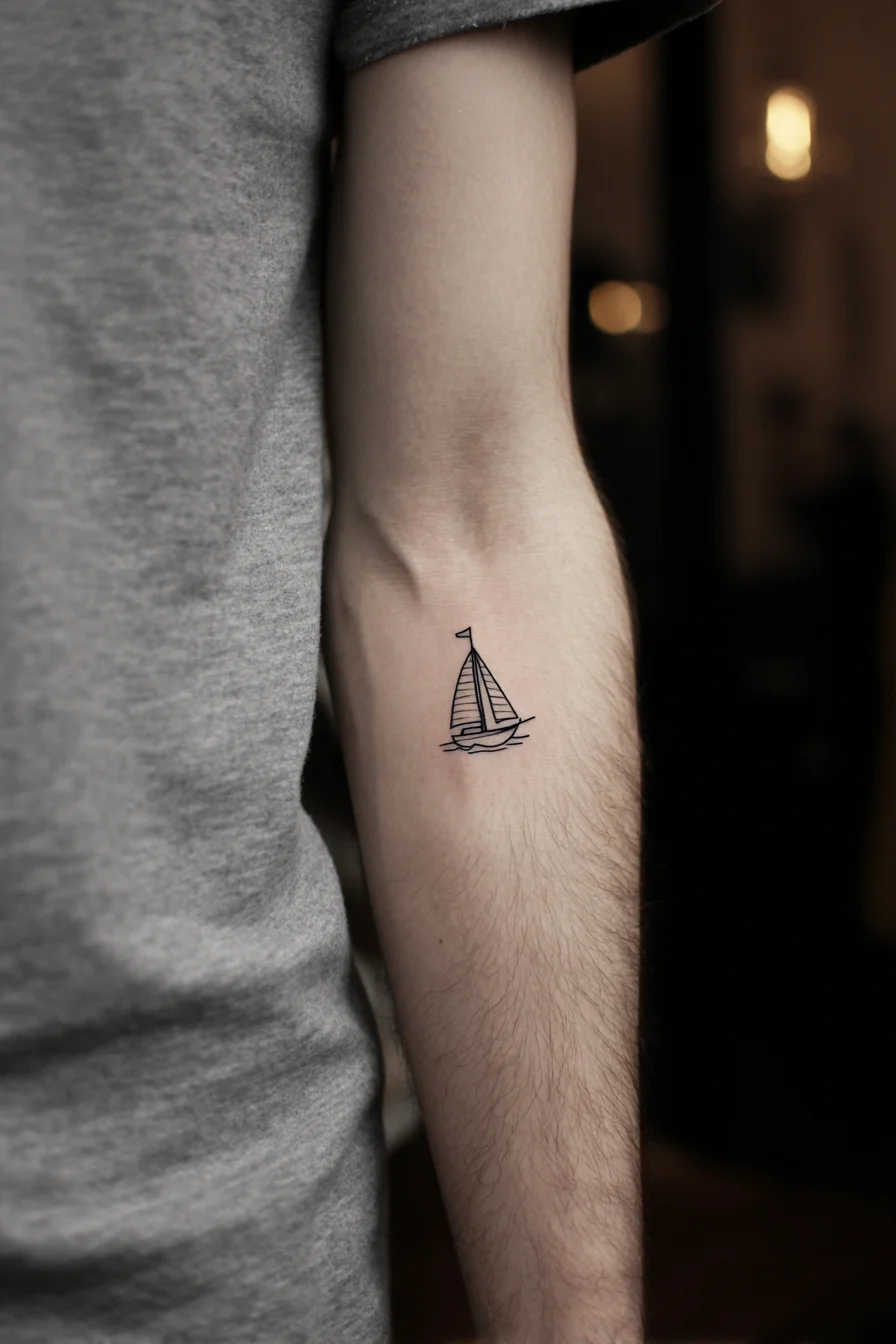
This clean, single-needle sailboat is a minimalist nautical piece that reads as both understated and symbolic — ideals of freedom, steady progress, and resilience on life’s journey. As shown, the inner forearm is an ideal placement for men who want visibility with the option to cover up when needed; other strong placements include the outer forearm, upper arm/bicep, chest pocket area or ankle depending on how masculine or discreet you want the piece. Pain expectations are generally low to moderate: the fleshy outer forearm and bicep are among the least painful, the inner forearm can be slightly more sensitive, and wrist/rib placements will be noticeably more intense. For size, keep this design small (about 2–4 cm/0.8–1.6 in) to retain sharp line detail; larger sizes allow for shading and added detail but may change the minimalist feel. Styling variations to consider: solid black single-line for longevity, light dotwork or stippling for texture, geometric sails, watercolor washes behind the boat, or combining with a compass or waves for a more traditional nautical composition. Ask your artist about needle choice and future touch-ups to preserve fine lines.
Peony Linework Forearm Tattoo — Masculine Floral Design
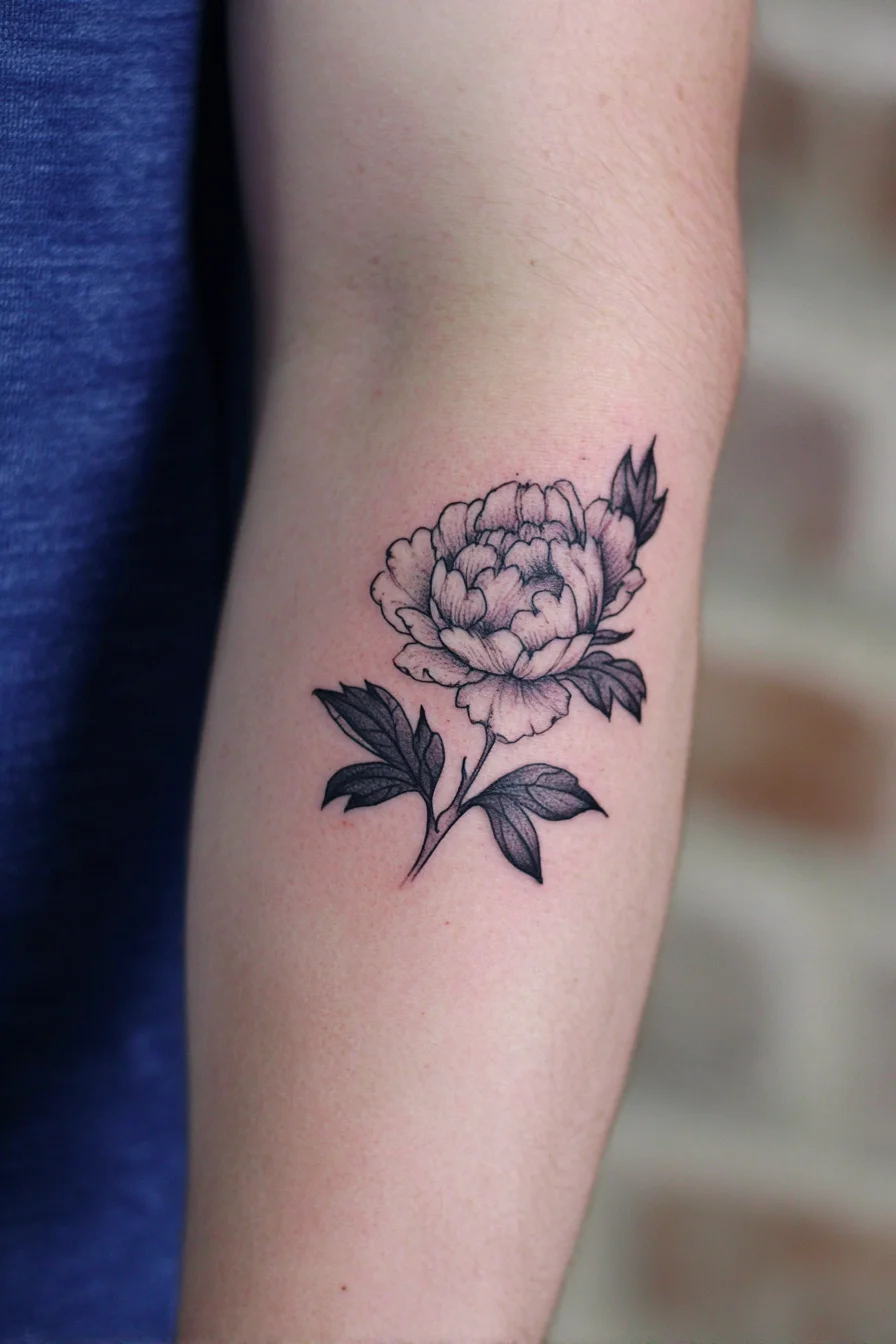
This peony linework forearm tattoo blends classic floral symbolism with clean single-needle shading, making it a strong choice for men who want a refined yet masculine piece. The peony traditionally symbolizes prosperity, honor and resilience; rendered in black and gray it reads more stoic and versatile on a male arm. Placement: the inner forearm (as pictured) offers visibility and easy aftercare—other solid options include the outer forearm, upper arm/biceps, chest or calf to suit broader compositions. Pain expectations: inner forearm is generally low-to-moderate pain; you’ll feel more pressure than sharp pain compared with high-sensitivity areas like ribs or ankles. Size considerations: 3–5 inches preserves petal detail and shading; scale up to 6–8 inches for background elements and color. Styling variations: convert to bold blackwork for contrast, add dotwork or geometric elements for a modern look, or go neo-traditional/Japanese with saturated color for a bolder statement. Ask your artist about line weight, needle choice and placement to ensure the design flows with muscle contours.
Minimal Flying Sparrow Tattoo — Small Blackwork Bird for Forearm
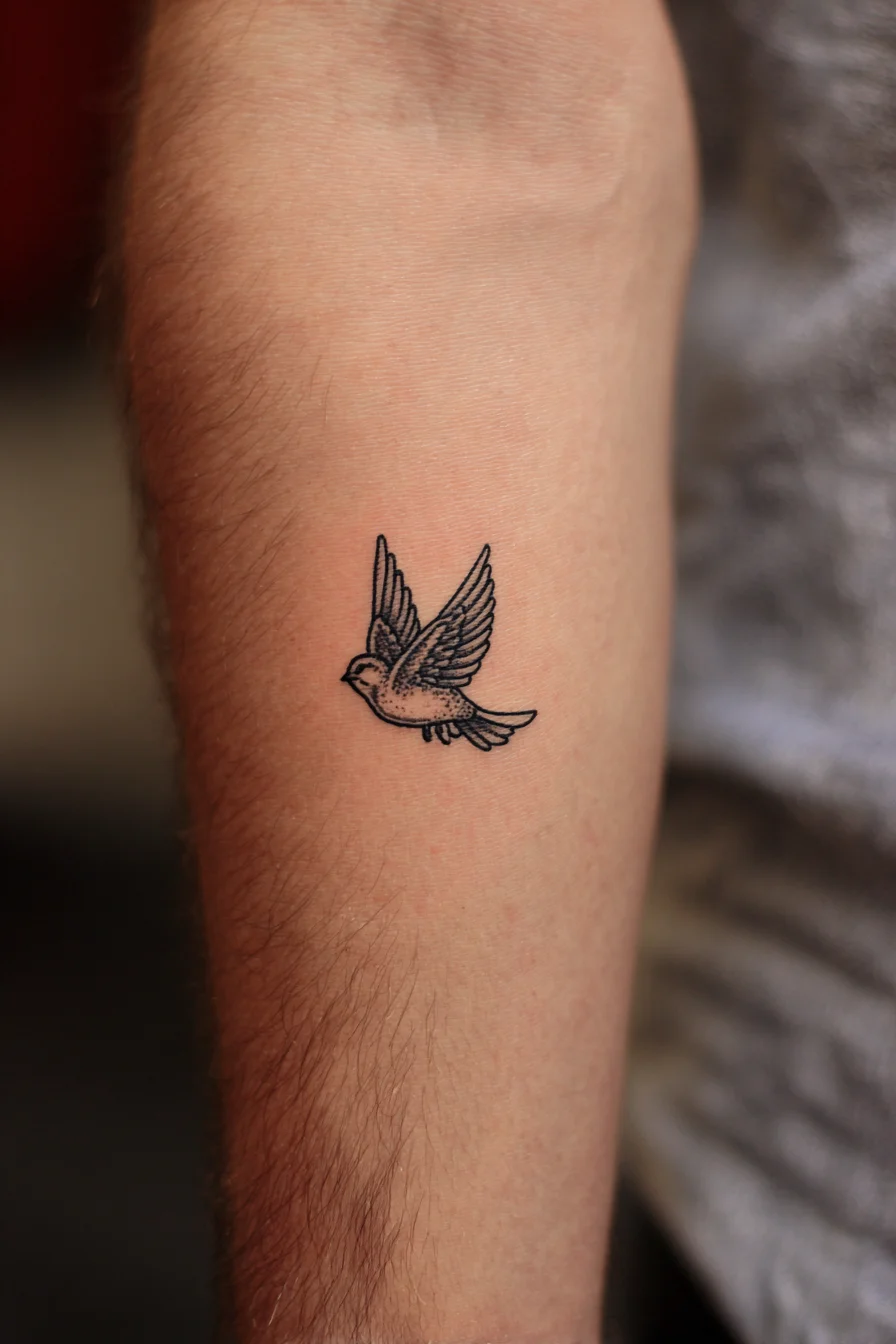
This small flying sparrow is a minimalist blackwork piece that reads as both classic and personal — common meanings include freedom, resilience, hope, and remembrance. Its clean lines and light stippled shading make it ideal for clients who want a meaningful, low-profile tattoo that still reads well at a glance. For placement, the inner or outer forearm (as shown) is a top pick for men because it offers visibility and low complication with muscle contours; other good options are the upper arm, chest near the pec, shoulder blade, or calf for a masculine yet subtle look. Expect mild to moderate pain: a small single-needle or fine-line blackwork tattoo typically takes 20–45 minutes and is less painful than work over bony areas; inner wrist or ribs will be more sensitive. Size considerations: 2–5 cm keeps the crisp detail intact — scale up if you want more shading or added elements. Styling variations include pure fine-line, dotwork shading, neo‑traditional color accents, geometric backgrounds, or a small flock composition; note that very fine styles may need touch-ups over time, so plan for aftercare and occasional maintenance.
Minimal Compass Rose Tattoo — Small Forearm Nautical Star
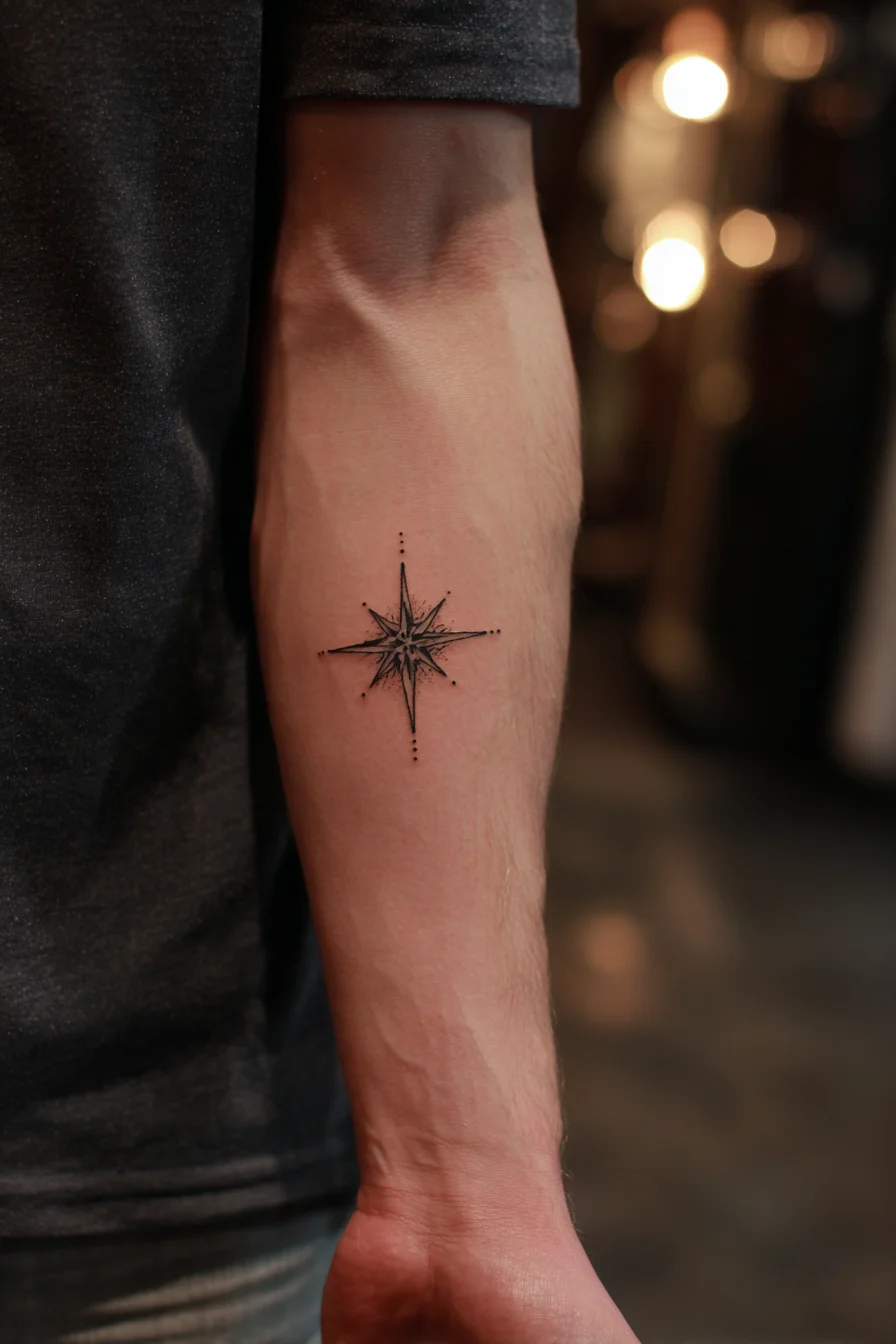
A compact compass rose or nautical star is a timeless symbol of direction, purpose, and resilience — a subtle statement piece for men who value navigation, travel, or personal guidance. This clean, minimalist rendition works especially well on the inner forearm as shown, offering straightforward visibility and a masculine vertical line that complements short sleeves. Placement alternatives include the outer forearm, wrist, biceps, chest, shoulder blade, or calf depending on how public or integrated you want the piece to be. Expect low-to-moderate pain on fleshy forearm zones; sensitivity increases closer to the wrist, elbow, or over bone. For detail retention, aim for at least 5–7 cm (2–3 inches); if you prefer a smaller size, request thicker line weights so the fine points and dot accents don’t blur over time. Styling options range from single-needle blackwork for crisp lines, to dotwork shading, bold traditional fills, subtle color accents, or integrating coordinates, map fragments, rope, or anchor elements for a larger sleeve composition. Consult your artist about line weight, stencil placement, and aftercare to ensure longevity and the final aesthetic you want.
Minimal Sunburst / Compass Inner Wrist Tattoo — Small Masculine Wrist Design
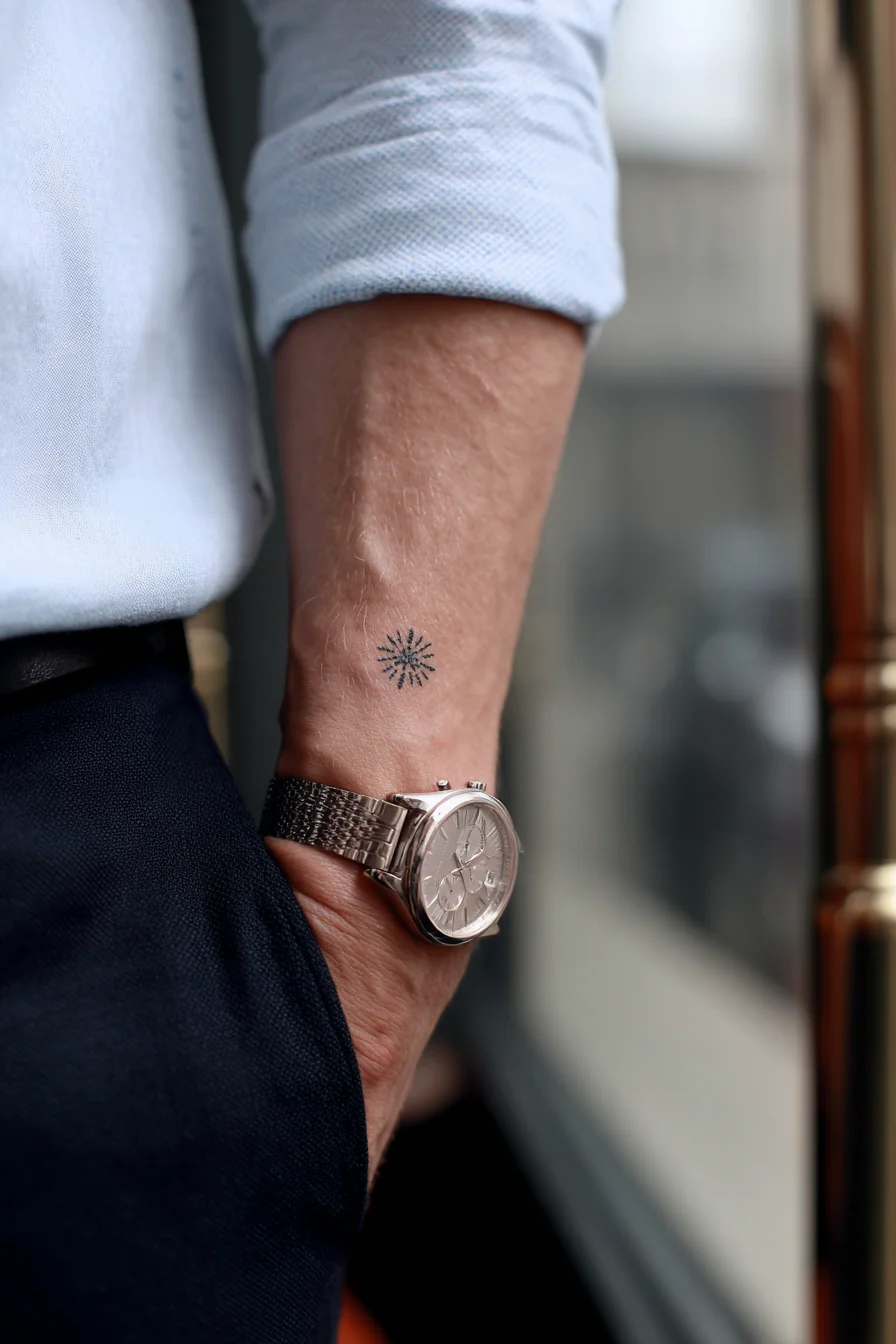
This compact sunburst/compass-style tattoo reads as a discreet symbol of direction, resilience and new beginnings. Its radial geometry makes a clean, masculine statement that’s ideal for men seeking subtle but meaningful body art. Placement suggestions: inner wrist for high visibility and personal resonance; outer wrist or inner forearm for slightly less sensitivity; behind the elbow or upper forearm when you want a more private option. Expect pain: the inner wrist has thin skin and proximity to tendons and nerves, so you’ll feel sharper, more intense sensations than on fleshy areas — however the small scale keeps sessions short (often 15–45 minutes) and tolerable. Size considerations: 1–3 cm preserves fine-line detail and ages well; scale up to 4–6 cm if you want shading, dotwork or additional elements. Styling variations: fine-line black for understated elegance, bold blackwork for high-contrast impact, dotwork or stippling to deepen texture, or subtle color accents (deep navy, rust) to personalize. Practical tip: avoid tight watches during healing and discuss placement with your artist to suit your daily wardrobe and sleeve plans.
Traditional Swallow & Ship Calf Tattoo — Nautical Old School Design
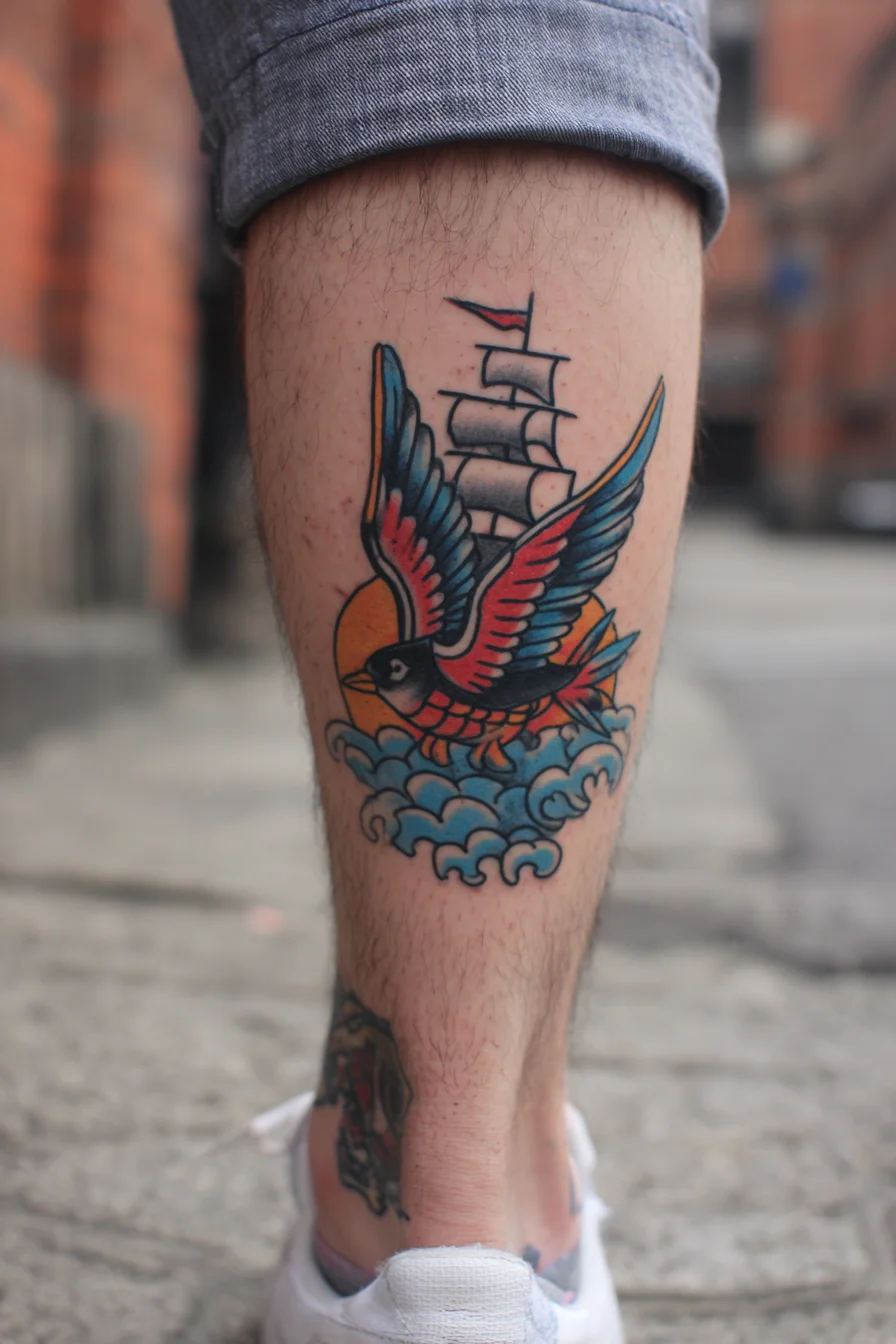
This bold neo-traditional piece combines a flying swallow, stylized waves, a rising sun and a stacked sailing ship — classic nautical motifs that symbolize safe passage, loyalty, freedom and a life of adventure. On the calf the design reads dynamically with muscle movement and suits men who want a statement that’s visible in shorts but easy to cover for work. Pain expectations are moderate: the outer calf and meatier parts tolerate ink well and are among the less painful leg areas; the inner calf, shin and ankle are more sensitive and may feel sharper. Size considerations matter for detail — small (3–4 inches) keeps the composition simple, medium (4–7 inches) is ideal for crisp color and ship rigging, and large pieces (8+ inches) allow full shading and background elements. Styling variations include strict American traditional color and thick outlines, a black-and-gray tonal version, neo-traditional with richer gradients, or a watercolor wash behind the bird. Optional additions: compass, anchor, rope banner or name ribbon to personalize meaning. Discuss placement, sizing and hair-shaving with your artist to match visibility and healing preferences.
Anatomical Heart Tattoo — Inner Forearm Linework for Men
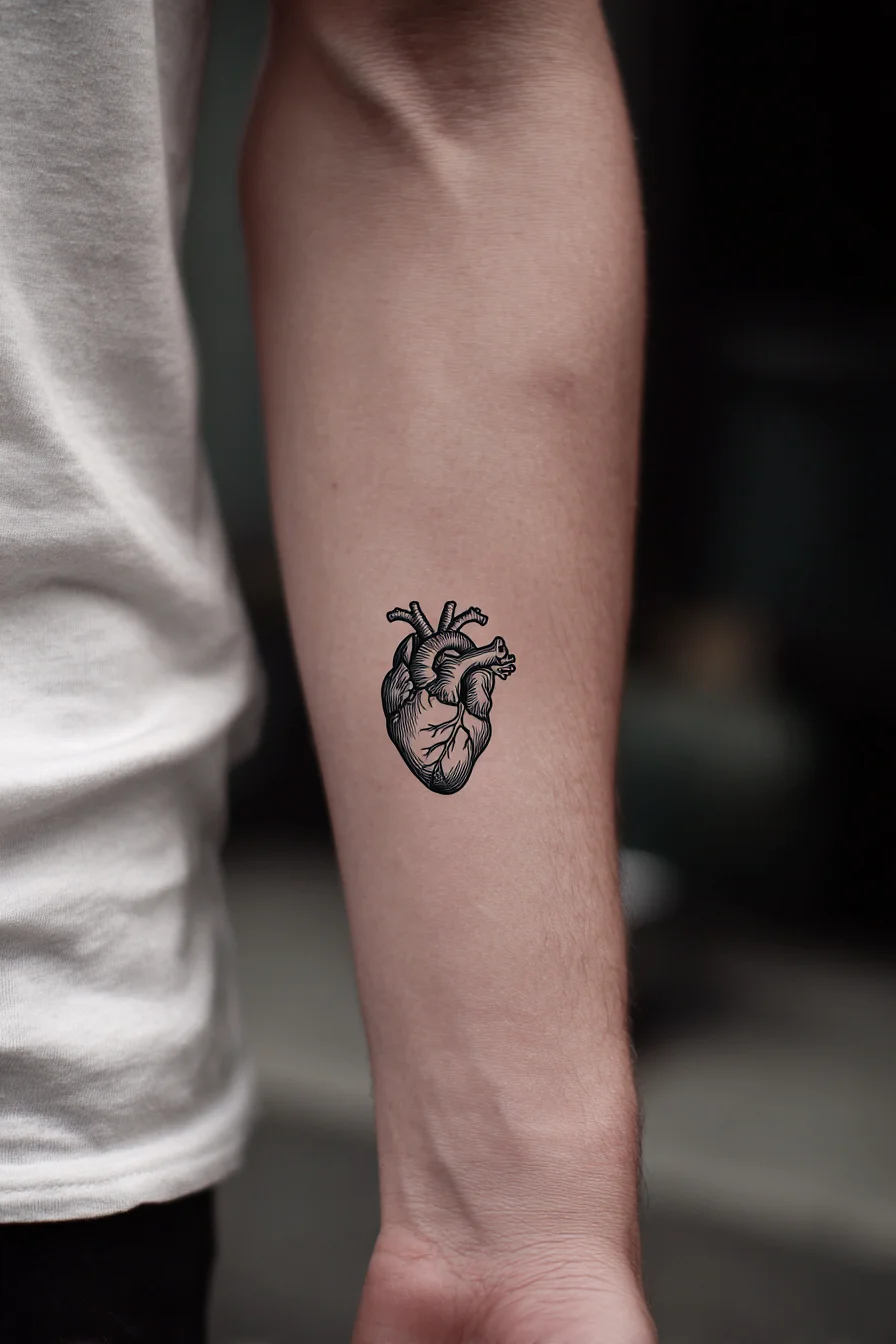
This small anatomical heart design reads as a bold statement of honesty, resilience and emotional authenticity. The realistic linework suggests vulnerability and strength simultaneously, making it a strong choice for men who want a meaningful, understated piece. Placement suggestions: the inner forearm (as shown) offers high visibility and easy aftercare; other masculine placements include the outer forearm, chest over the real heart, upper arm or near the ribs if you want a more private placement. Pain level expectations: inner-forearm work is typically low-to-moderate on the pain scale due to softer tissue and fewer nerve-dense areas; expect higher discomfort on ribs, sternum or wrist. Size considerations: keep this style around 2–3 inches to preserve fine-line detail; scale up to 4–6 inches for more shading or photorealism. Longevity note: very fine lines may blur over years, so consider slightly thicker strokes for durability. Styling variations: black fine-line engraving, stippling/dotwork, geometric framing, or a muted watercolor wash for contrast. Discuss sizing and level of realism with your artist to match aesthetic and lifestyle.
## Minimal Heart-Cross Line Tattoo — Calf & Forearm Placement
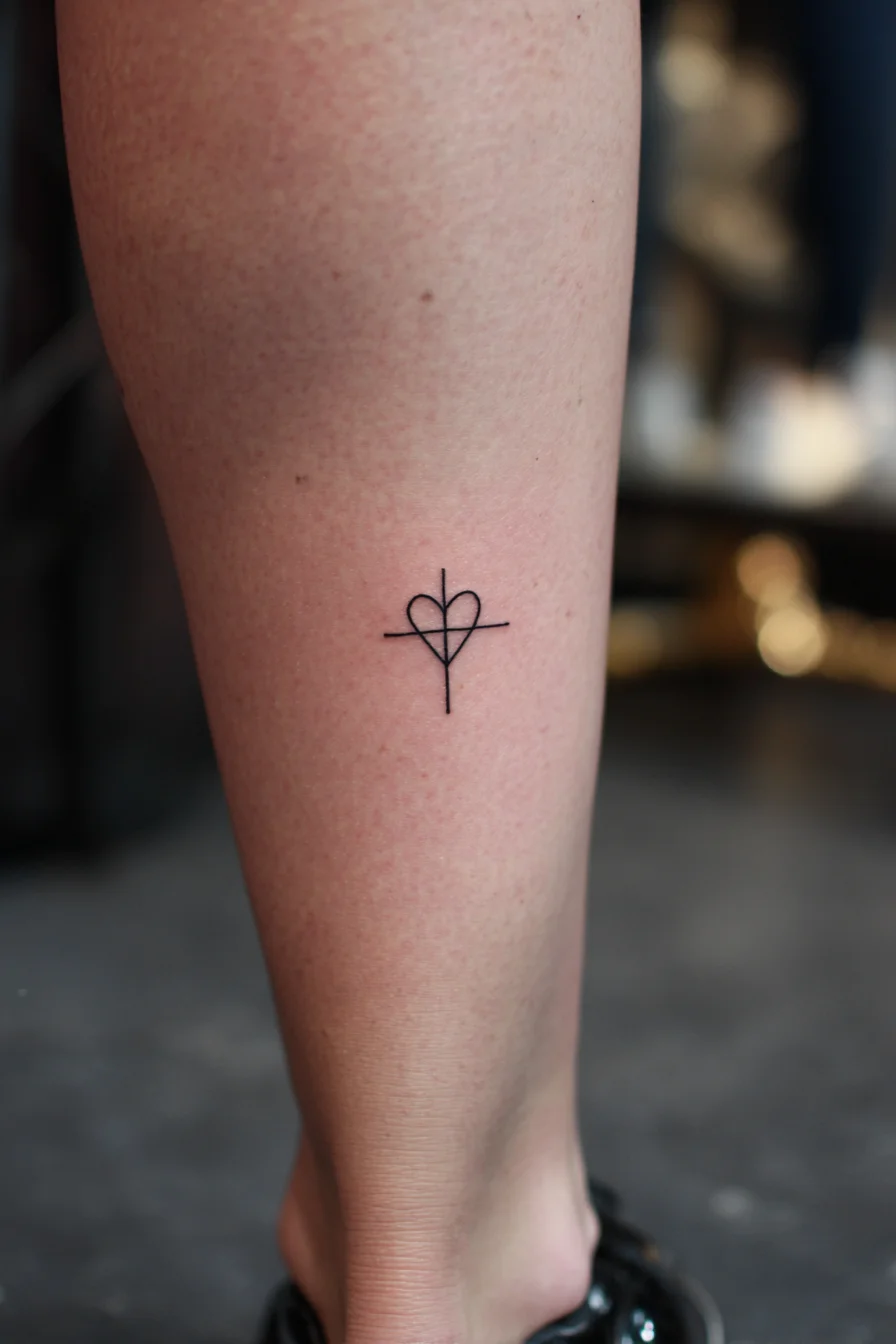
Subtle, geometric heart intersected by a horizontal and vertical line creates a compact symbol of balance, grounded love, and personal resilience. Its minimal single-needle linework reads modern and masculine while remaining discreet. Placement suggestions: ideal on the calf (inner or outer), forearm, upper arm, behind the shoulder, or near the sternum for a compact focal point. On the calf it sits naturally with muscle flow; on the forearm it offers frequent visibility. Pain expectations: with thin, single-line work pain is generally low to moderate — forearm and outer calf tend to be milder, inner calf, ribs or sternum can be more sensitive. Sessions are short (30–60 minutes) which helps manage discomfort. Size considerations: preserve crispness by keeping the design at least 2–3 cm wide; very small versions can blur over years so consider slightly bolder lineweights for longevity. For men wanting more presence scale up to a 5–8 cm piece. Styling variations: solid black vs. fine-line, thickened outlines, negative-space fills, color accents (red or navy), or integrate into geometric sleeves or script for personal meaning.
Lotus Wrist Tattoo — Fine-Line Floral Forearm Design for Men
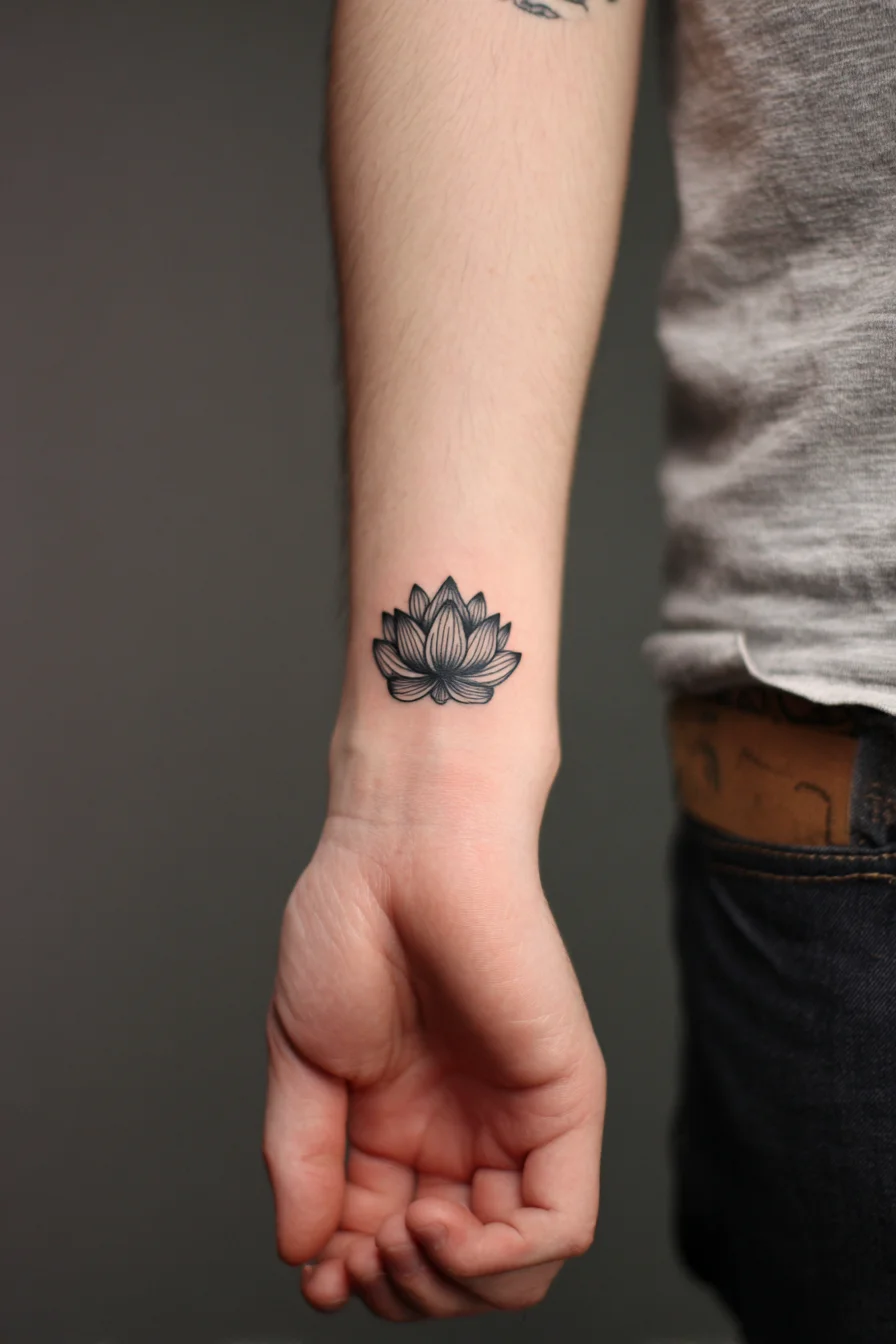
This small lotus motif reads as a calm, grounded symbol of growth, resilience and renewal — a good choice for men seeking subtle spiritual or aesthetic meaning without overt flash. Placement on the inner wrist or low forearm keeps the piece visible and personal; alternatives that suit masculine placements include the outer forearm, upper arm, chest over the sternum, or integrated into a sleeve. Expect the wrist area to be moderately sensitive: thin skin over tendons and bone can make sessions sting more than fleshy locations, while the forearm is generally lower-pain and easier to heal. Size considerations: 2–6 cm preserves detail and looks balanced on most wrists; very small, ultra-fine lines can blur over years, so discuss slightly bolder outlines or spaced petal lines with your artist for longevity. Styling variations to suit a masculine aesthetic include blackwork or geometric framing, dotwork shading, heavier lineweight, or muted color accents. For consultation: bring reference images, agree on line thickness and contrast, and follow standard aftercare (keep clean, moisturize, avoid sun) to protect crisp detail.
Small tattoos punch above their size when they’re well planned. From my 10+ years advising clients, the keys are simple: choose a design that reads clearly at small scale, match line weight to placement, and book an artist experienced in fine-line or micro work. Test visibility with temporary options, be realistic about pain and fading on areas like fingers and hands, and budget for potential touch-ups after healing. Prioritize black or muted tones for longevity, follow studio aftercare, and avoid sun exposure while the piece settles. If you’re unsure, schedule a short consult — bringing reference images and explaining lifestyle or career needs helps me and other pros tailor a small tattoo that ages gracefully. These 22 examples are meant to inspire restrained, meaningful ink you’ll be proud to wear.
